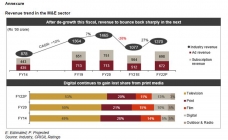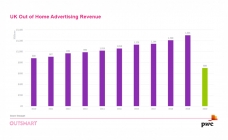Global consumer spending on media content & tech surges 6.1% in 2020: PQ Media
By M4G Bureau - March 02, 2021
Overall digital media content devices was the largest of the nine major digital and traditional media platform categories in 2020, generating $440.5 billion
Global consumer spending on media content and technology grew an estimated 6.1% to $2.012 trillion in 2020, driven by the COVID-19 lockdown that kept consumers at home binging on multiple forms of digital entertainment as relief from the pandemic, according to new research from PQ Media. The gain was a sharp acceleration from the 3.8% growth in 2019, signaling the fastest expansion in both global and US consumer media & tech spending in five years, fuelled by surging expenditures on streaming audio and video subscription services, and digital and console-based videogame software and hardware, according to PQ Media’s Global Consumer Spending on Media Forecast 2020-2024.
 If not for traditional film & home video spending plummeting after movie theatres were shuttered worldwide, consumer media spending growth would have been the strongest in 10 years worldwide, while US media spending growth would have been the fastest since 1996. Consumer media spending growth is projected to slow in 2021, but only slightly to 6.0%, as many consumers remain at home working, children continue schooling virtually, more fiscal stimulus is distributed, and moviegoers begin returning to theatres later in the year.
If not for traditional film & home video spending plummeting after movie theatres were shuttered worldwide, consumer media spending growth would have been the strongest in 10 years worldwide, while US media spending growth would have been the fastest since 1996. Consumer media spending growth is projected to slow in 2021, but only slightly to 6.0%, as many consumers remain at home working, children continue schooling virtually, more fiscal stimulus is distributed, and moviegoers begin returning to theatres later in the year.
“Nevertheless, PQ Media expects the growth of consumer spending on media content and technology will begin to decelerate markedly in 2022 and 2023, as many of the pandemic-driven forces that sparked the atypical end-user spending splurge in 2020 begin to fade in the second half of 2021, as the COVID-19 vaccine rolls out worldwide, adult workers begin returning to office buildings and children start repopulating physical schools,” said PQ Media CEO Patrick Quinn. “We forecast last year that consumer media spending would likely reach an inflection point and stop growing in 2023. While the pandemic briefly interrupted key secular trends in 2020, this was a near-term disruption of long-term trends that will resume in the 2021-2024 period, such as the deceleration of growth or outright decline of expenditures on print newspapers, magazines and directories, as well as mobile phones, DVDs and in-theatre movie tickets.”
Overall digital media content devices was the largest of the nine major digital and traditional media platform categories in 2020, generating $440.5 billion, while digital content subscriptions was the fastest growing, up 20.7%. The shift to digital media content and technology is clearly evident in the 12-point shift in market share to digital from traditional media in the 2014-2020 period, as the digital segment now commands 71.1% of all consumer media outlays, according to the Global Consumer Spending on Media Forecast 2020-2024.
Consumer spending on all media content & tech worldwide averaged $352.96 per capita in 2020, up 5.3% from 2019, driven by strong growth in digital media streaming services. Of the 28 digital media categories, the fastest growing in 2020 was digital audio subscription services, which rocketed 40.0% to $30.98 billion worldwide. The growing popularity of podcasts was among the primary drivers behind the double-digit increase, as Spotify, iHeart and Amazon all dived deeply into podcasting in 2020, striking numerous deals involving new talent, content and ad services. The number of US podcast listeners grew more than 30% to more than 100 million in 2020, when Spotify acquired sports and pop culture network “The Ringer” and the exclusive rights to “The Joe Rogan Experience,” while Amazon Music and Audible added over 100,000 new and original podcast channels and shows, featuring celebrities like DJ Khaled and Will Smith.
Global consumer spending on OTT video services, including streaming video subscriptions and SVOD programming, was the second-fastest growing digital media category, soaring almost 30% in 2020. New streaming video services proliferated during the year as their audiences grew simultaneous to COVID-19 forcing consumers indoors for longer periods. Netflix added 26 million global subscribers in 1H20 compared to only 12 million in 1H19, as original hit series like “Tiger King” and “The Queen’s Gambit” provided fresh content to growing stay-at-home audiences. Just one year after its launch, Disney+ amassed nearly 75 million paid subscribers by year-end 2020.
Meanwhile, consumer spending on traditional film & home video plummeted 46.2% in 2020 to $43.05 billion. “While we expect to see an uptick in the growth of in-theatre movie ticket sales in 2021 and 2022, albeit versus extremely deflated comps in 2020 and 2021 – PQ Media believes that physical movie ticket spending, as well as the entire film & home DVD category, will never again reach the high water mark of nearly $85 billion in 2019,” Quinn said.
A good portion of the near-term growth in movie ticket sales will be the result of the staggered delays of blockbuster movies throughout the 2020-2024 period, due to the plethora of halted productions during the pandemic lockdowns. “Perhaps even more critical is the massive shift to streaming video services in recent years, which was amplified by the stay-at-home orders in 2020 and further accentuated when major studios decided to test the streaming waters by launching several hit movies via OTT video services in 4Q20,” Quinn added.
Among the studios that took the leap – and much criticism from theatre chain owners and traditionalist producers, directors and actors – were Disney, which debuted both “Mulan” and “Soul” on its Disney+ service, and Warner Media’s simultaneous release of the much-anticipated “Wonder Woman ‘84” in theatres and on HBO Max.
While videogames tend to buck trends in typical years, with spending slowing down or declining prior to major hardware upgrades, this was not the case in 2020, as digital videogame software and hardware spending on multiplayer online games, various gaming apps, in-game microtransactions and traditional console-based gaming all surged throughout the year – even before the long-awaited releases of Sony’s PlayStation 5 and Microsoft’s Xbox Series X in 4Q20.
Of the 14 traditional media & tech categories, cable TV subscriptions remained the largest at $220.6 billion, followed by print books & directories, and newspaper & magazine subscriptions. Print books & directories was the fastest growing traditional media spending category, up 7.8%, as 10 of the 14 traditional categories grew in 2020, including pay-per-view and TV sets.
The US remained the largest global market in 2020 with total consumer media spending of $472.16 billion (23.5% share), followed by China, Japan and India. Russia was the fastest growing market, up 10.8%, trailed by South Africa, India and Argentina. Japanese consumers spent the most per-capita, averaging $1,486.02 in 2020, while the US ranked third with per-capita spend of $1,419.45.

Stay on top of OOH media trends








